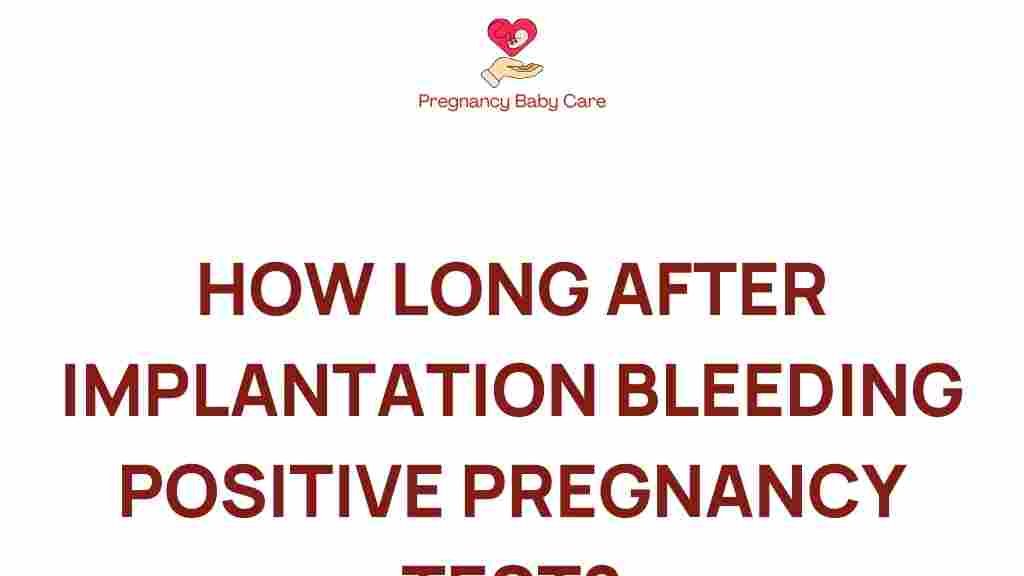Unraveling the Mystery: How Soon Can You Test Positive After Implantation Bleeding?
For many women trying to conceive, understanding the signs and timing of early pregnancy can be a perplexing journey. One common question that arises is: “How soon can I test positive after experiencing implantation bleeding?” This article aims to unravel this mystery by exploring the relationship between implantation bleeding, positive pregnancy tests, and the various factors that influence early pregnancy symptoms and hormone levels.
What is Implantation Bleeding?
Implantation bleeding is a light spotting that occurs when a fertilized egg attaches itself to the lining of the uterus. This process typically happens about 6 to 12 days after conception, which is when you might first notice signs of early pregnancy. Understanding this phenomenon is crucial for anyone eager to know when they can expect a positive pregnancy test.
When Does Implantation Bleeding Occur?
To comprehend how soon you can test positive after implantation bleeding, it’s essential to understand timing:
- Conception: This occurs when a sperm fertilizes an egg, usually within 24 hours after ovulation.
- Implantation: After conception, the fertilized egg travels to the uterus, where it implants itself into the uterine lining, leading to implantation bleeding.
- Timing: Implantation bleeding typically occurs between 6 to 12 days post-ovulation, aligning with the luteal phase of the menstrual cycle.
Understanding Hormone Levels
After implantation, the body begins to produce the hormone human chorionic gonadotropin (hCG), which is crucial for maintaining pregnancy. The levels of hCG can be detected in urine and blood tests, making it a reliable marker for confirming pregnancy.
- hCG Levels: The hormone hCG doubles approximately every 48 to 72 hours in early pregnancy.
- Testing Methods: Home pregnancy tests (HPTs) detect hCG in urine, while blood tests conducted by a healthcare provider can measure hCG levels more accurately.
How Soon Can You Test Positive After Implantation Bleeding?
After experiencing implantation bleeding, many women wonder when they can take a pregnancy test. Here’s a step-by-step process to help you determine the best timing:
Step 1: Wait for the Right Time
Since implantation typically occurs 6 to 12 days after conception, most women can expect to take a pregnancy test about 1 to 2 weeks after suspected ovulation. Here’s a breakdown:
- If you have a regular 28-day cycle, ovulation usually occurs around day 14.
- Implantation bleeding might occur between days 20 to 26.
- A pregnancy test is most reliable when taken after the first missed period, typically around 14 days after ovulation.
Step 2: Choose the Right Testing Method
There are two primary methods to test for pregnancy:
- Home Pregnancy Tests (HPT): These tests are widely available and can be done at home. For the most accurate results, follow these tips:
- Test in the morning when urine concentration is highest.
- Follow the instructions carefully for accurate results.
- Wait at least a few days after implantation bleeding for the best chance of detecting hCG.
- Blood Tests: These tests are conducted at a healthcare facility and can detect lower levels of hCG than most HPTs. They can provide results as soon as 6-8 days after ovulation.
Step 3: Understanding Test Sensitivity
The sensitivity of pregnancy tests varies between brands. Some tests can detect hCG levels as low as 10 mIU/ml, while others may require levels of 25 mIU/ml or higher. Here’s how to choose:
- Check the packaging for the sensitivity level of the test.
- Choose highly sensitive tests if you want to test early after implantation bleeding.
Common Pregnancy Symptoms After Implantation Bleeding
Aside from implantation bleeding, there are other early pregnancy symptoms to watch for:
- Missed Period: The most obvious sign of pregnancy.
- Nausea or Morning Sickness: Often starts around 6 weeks of pregnancy.
- Breast Changes: Tenderness or swelling in the breasts can occur early on.
- Fatigue: Increased tiredness is common in early pregnancy due to hormonal changes.
- Frequent Urination: This can start as early as 6-8 weeks after conception.
Troubleshooting: What If You Don’t Get a Positive Test?
If you do not receive a positive pregnancy test after implantation bleeding, consider the following troubleshooting tips:
- Timing: You may have tested too early. Wait a few days and test again.
- Test Sensitivity: Ensure you’re using a highly sensitive test, especially if testing early.
- False Negatives: If you receive a negative result but still suspect pregnancy, consult a healthcare provider for a blood test.
- Other Conditions: Implantation bleeding can be confused with menstrual irregularities. If you have any concerns, speak with your healthcare provider.
Conclusion
Understanding the timing of implantation bleeding and when to test for a positive pregnancy result can be crucial for those trying to conceive. Remember that implantation bleeding typically occurs 6 to 12 days after conception, and the best time to take a pregnancy test is about 1 to 2 weeks after ovulation or after a missed period.
By paying attention to your body’s signals and using the right testing methods, you can increase your chances of detecting a positive pregnancy test early. If you have any concerns about your symptoms or testing results, don’t hesitate to reach out to a healthcare professional for guidance.
For more information on early pregnancy signs, visit this resource. And to explore different fertility methods and tips, check out this informative article.
This article is in the category Pregnancy and created by PregnancyBabyCare Team
